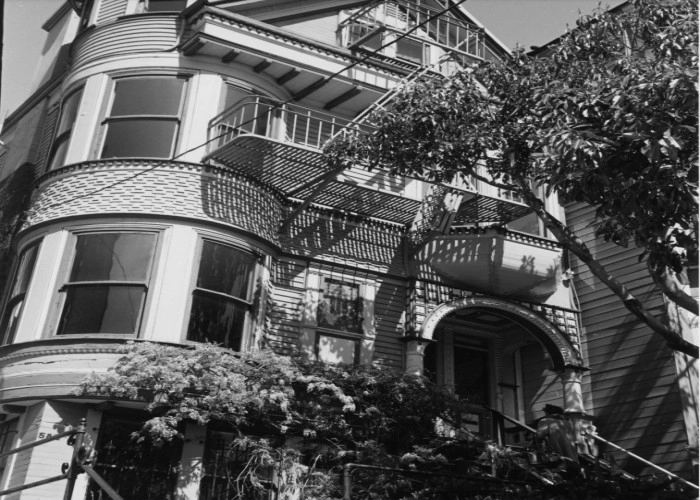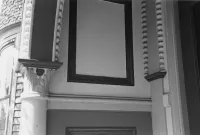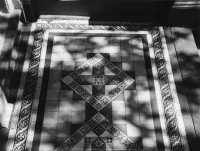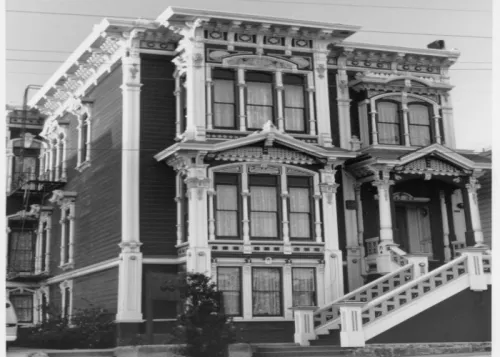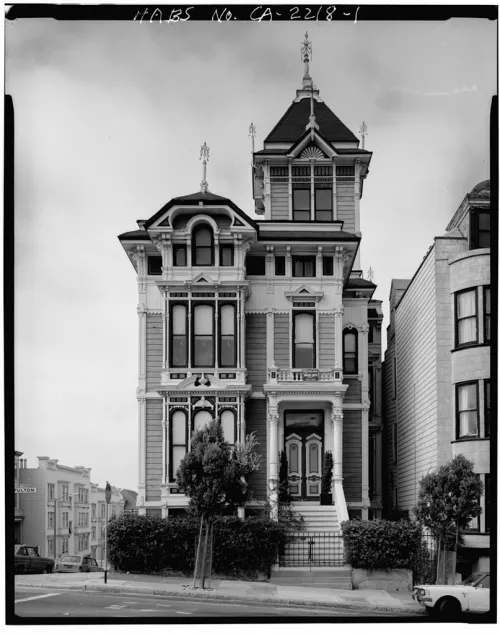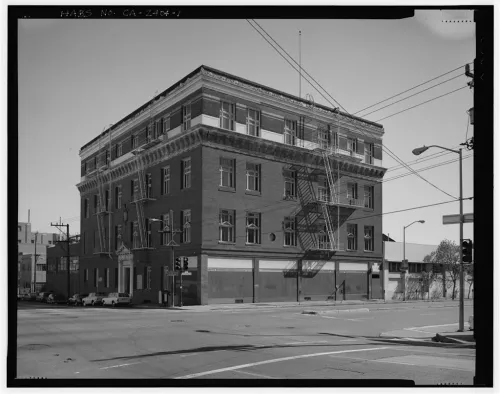Share what you know,
and discover more.
Share what you know,
and discover more.
Sep 12, 1985
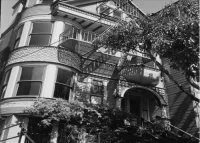
-

- Charmaine Bantugan
House at 584 Page Street - National Register of Historic Places
Statement of Significance: The house at 584 Page Street is significant as a towered Queen Anne "building virtually intact outside and in, with an unusual fine surviving "bathroom. Probably the oldest intact structure on its block, 584 Page stands out from the other 384 Queen Anne tower houses surveyed in San Francisco (l) because of its exterior integrity and its interior details which reveal the juxtaposition of styles—Eastlake, Queen Anne, Classical Revival and a little bit of Art Nouveau—typical of contractor designing. With this house its contractor-"builder Daniel Einstein began the mature and most productive phase of his at least 90-house career. The bathroom, described above in Item 7, has been highly rated by Hank Dunlop, Program Head of Interior Architecture Design at the California College of Arts and Grafts; Of most importance, is the original bathroom found on the second floor. The wood paneling in this room is truly unique. It is in the Queen Anne /Eastlake style of the quality normally found in entry halls, libraries, studies, or dining rooms of much grander homes. The clever way this paneling in combined with standard fixtures and ceramic tile along with the unusual means of bringing daylight into the room (the lightwell with window and skylight) is worth preserving. In my extensive studies of the 19th century interiors, I have never seen a bathroom of this nature. The second-floor bathroom alone is such a find that it makes 584 Page a unique late 19th century home. This bathroom, combined with the moderate contractor/builder quality of the house makes it a desirable property for the National Register. Pattern book precedents exist for some of the interior details. The bathroom paneling, for instance, resembles that in the entry hall of John G. Pelton's "Seven-Boom Cottage" of 1882, and also that in William T. Comstock's l88l designs for the "Inside Finish of a Summer Cottage." The Newsom's first catalogue (1884) shows one door surround interrupted by chair molding bands that do not continue along the wall. The same book contains two designs for stair balusters that together could have inspired the ones in the subject house. Daniel Einstein (1857-after 1906) is identified as 584 Page's developer builder on the water Application for Service Installation of 16 April 1894, and by two deeds. On 25 March. I894 Elias J. "Lucky" Baldwin, the multi-millionaire mining stock and land speculator, horse racer and hotelier shown as owner of the property on the I894 Block Book, recorded his sale of the 50-foot lot now occupied by 584 and 590 Page for S4875 to Daniel Einstein. (4) On 12 September 1894 Einstein and his wife Ellen recorded their deed of 584 Page (north Page, 50' east of Fillmore, east 25x100') to W. W. Van Arsdale for an undisclosed sum. (5) Chronologically this was the thirteenth house of at least ninety built by Einstein and identified through the San Francisco Recorder's General Index. Einstein was first listed in the San Francisco Directory of 1892, as a real estate dealer, but he executed his first deed in San Francisco in November I89I. The 1900 Census indicates he was born in Germany in June 1857, had come to this country in 1875, and had been married (without children) since 1885. A San Francisco Index of Naturalized Voters says he became a United States citizen in New York in l879, but a search of directories for New York and other cities has produced no clue to his whereabouts or occupation(s) between the 1875 immigration and the San Francisco arrival about I89I. Equally mysterious is his departure from the city. His last known San Francisco actions were to record two leases in October I9O6. He is not listed in any subsequent San Francisco Directory, in the index to the 1910 Census, nor in the State Death Index. He must have departed from the state or the country, leaving behind a power of attorney executed in 1902 but recorded in January 1907. Between 1891 and 1906 Daniel Einstein carved himself a substantial niche in San Francisco as a builder, developer and contractor. A I9OI newspaper real estate column spoke of him familiarly: Dan Einstein has disposed of one of the colonial residences erected by him on the east line of Lyon Street, 155 north of Clay Street, for S8,250. There are several prospective buyers for the other two negotiating. In directories he was listed as a real estate dealer I892 and I893, as a contractor and builder 1894 through 1899, as a contractor I90O and 1901, and as a builder with office in the Chronicle Building 1902 through 1905. He was not alone: Lynch Waldhorn claims there were in the Victorian period "more than seven hundred" contractors and "several hundred" owner-builders, but she names only seven of the former and six of the latter, illustrating some ornamentation by seven of them. She gives Einstein the prominence of both name and illustration. (7) His ninety-odd houses identified through officially recorded documents include only seventeen built on contract, leading to an assumption either that he did not record all his contracts or, more likely, that the bulk of his business was as an owner-builder, or developer. Einstein commenced his business gradually 1891-1893, with a dozen Queen Anne cottages on Noe, 22nd and Sanchez Streets, well south of Market. Only one, 952 Sanchez, was a full two-story house, though hilly terrain led to full basements in most of the others. With this solid experience he ventured into more expensive, and potentially more lucrative, areas north of Market. He began in 1893 with a two-story L-plan Queen Anne house at 288? Bush Street, next purchased the 50-foot lot from Baldwin where he built and sold 590 and 584 Page. In the rest of 1894, 1895 and 1896 he was working on Scott, Pell and Baker Streets, building houses in a mixture of Queen Anne and Colonial Revival styles. Of these first ten houses north of Market presumably built by Einstein (8), four have been covered with stucco or asbestos and four are less pretentious structures without towers. The L-plan experiment of 2887 Bush Street was not repeated, probably because it required too much land. The first tower house Einstein ever built was 584 Page, and towers became an Einstein theme; many of his later Colonial Revival houses feature an almost tower-like curved bay window, for instance in the 100 block of Central Avenue. Einstein's later work, some sixty buildings, was all Colonial Revival houses and flats, the majority in or near the Haight Ashbury district between Market Street and Golden Gate Park, most of the rest in the southwest part of Pacific Heights. Thus, the construction, tower and sale of 584 Page, by affirming that Einstein could indeed-compete successfully in the lucrative medium-large house market between Golden Gate Park and Market Street, pivoted his career into its most productive phase. His customer at 584 Page was William Wilson van Arsdale, 1874 graduate of the University of California and in 1894 cashier at Sisson, Crocker and Company, general merchants. Later he became a partner in Scott and Van Arsdale, lumber merchants, owning the Ridgewood Ranch in Mendocino County. (9) He never lived on Page Street, but on Washington near Laguna. His deed selling 584 Page in I899 gives his abode then as Siskiyou County. (10) The 1899 buyer was Daniel Brown of Petaluma, a 65-year-old Irish capitalist naturalized by the naturalization of his father, (ll) Brown never lived in the house either, but according to the 1900 Census his tenants were his daughter and son-in-law, Nathalie and John J. O'Connor, with his son Vincent P. Brown, medical student, as a "boarder. Ownership passed to the Daniel Brown Estate Company, and title clearance after the 1906 earthquake and fire was handled "by daughter Emma R. Brown. (12) The 1910 Census taker found at the house Emma, her two sisters and widowed mother (each with an independent income) and her brother Vincent P. Brown, now a physician-specialist. These are the people who presumably had the chimney rebuilt, the mantels replaced and the five-panel doors installed. They left the wonderful bathroom intact.
House at 584 Page Street - National Register of Historic Places
Statement of Significance: The house at 584 Page Street is significant as a towered Queen Anne "building virtually intact outside and in, with an unusual fine surviving "bathroom. Probably the oldest intact structure on its block, 584 Page stands out from the other 384 Queen Anne tower houses surveyed in San Francisco (l) because of its exterior integrity and its interior details which reveal the juxtaposition of styles—Eastlake, Queen Anne, Classical Revival and a little bit of Art Nouveau—typical of contractor designing. With this house its contractor-"builder Daniel Einstein began the mature and most productive phase of his at least 90-house career. The bathroom, described above in Item 7, has been highly rated by Hank Dunlop, Program Head of Interior Architecture Design at the California College of Arts and Grafts; Of most importance, is the original bathroom found on the second floor. The wood paneling in this room is truly unique. It is in the Queen Anne /Eastlake style of the quality normally found in entry halls, libraries, studies, or dining rooms of much grander homes. The clever way this paneling in combined with standard fixtures and ceramic tile along with the unusual means of bringing daylight into the room (the lightwell with window and skylight) is worth preserving. In my extensive studies of the 19th century interiors, I have never seen a bathroom of this nature. The second-floor bathroom alone is such a find that it makes 584 Page a unique late 19th century home. This bathroom, combined with the moderate contractor/builder quality of the house makes it a desirable property for the National Register. Pattern book precedents exist for some of the interior details. The bathroom paneling, for instance, resembles that in the entry hall of John G. Pelton's "Seven-Boom Cottage" of 1882, and also that in William T. Comstock's l88l designs for the "Inside Finish of a Summer Cottage." The Newsom's first catalogue (1884) shows one door surround interrupted by chair molding bands that do not continue along the wall. The same book contains two designs for stair balusters that together could have inspired the ones in the subject house. Daniel Einstein (1857-after 1906) is identified as 584 Page's developer builder on the water Application for Service Installation of 16 April 1894, and by two deeds. On 25 March. I894 Elias J. "Lucky" Baldwin, the multi-millionaire mining stock and land speculator, horse racer and hotelier shown as owner of the property on the I894 Block Book, recorded his sale of the 50-foot lot now occupied by 584 and 590 Page for S4875 to Daniel Einstein. (4) On 12 September 1894 Einstein and his wife Ellen recorded their deed of 584 Page (north Page, 50' east of Fillmore, east 25x100') to W. W. Van Arsdale for an undisclosed sum. (5) Chronologically this was the thirteenth house of at least ninety built by Einstein and identified through the San Francisco Recorder's General Index. Einstein was first listed in the San Francisco Directory of 1892, as a real estate dealer, but he executed his first deed in San Francisco in November I89I. The 1900 Census indicates he was born in Germany in June 1857, had come to this country in 1875, and had been married (without children) since 1885. A San Francisco Index of Naturalized Voters says he became a United States citizen in New York in l879, but a search of directories for New York and other cities has produced no clue to his whereabouts or occupation(s) between the 1875 immigration and the San Francisco arrival about I89I. Equally mysterious is his departure from the city. His last known San Francisco actions were to record two leases in October I9O6. He is not listed in any subsequent San Francisco Directory, in the index to the 1910 Census, nor in the State Death Index. He must have departed from the state or the country, leaving behind a power of attorney executed in 1902 but recorded in January 1907. Between 1891 and 1906 Daniel Einstein carved himself a substantial niche in San Francisco as a builder, developer and contractor. A I9OI newspaper real estate column spoke of him familiarly: Dan Einstein has disposed of one of the colonial residences erected by him on the east line of Lyon Street, 155 north of Clay Street, for S8,250. There are several prospective buyers for the other two negotiating. In directories he was listed as a real estate dealer I892 and I893, as a contractor and builder 1894 through 1899, as a contractor I90O and 1901, and as a builder with office in the Chronicle Building 1902 through 1905. He was not alone: Lynch Waldhorn claims there were in the Victorian period "more than seven hundred" contractors and "several hundred" owner-builders, but she names only seven of the former and six of the latter, illustrating some ornamentation by seven of them. She gives Einstein the prominence of both name and illustration. (7) His ninety-odd houses identified through officially recorded documents include only seventeen built on contract, leading to an assumption either that he did not record all his contracts or, more likely, that the bulk of his business was as an owner-builder, or developer. Einstein commenced his business gradually 1891-1893, with a dozen Queen Anne cottages on Noe, 22nd and Sanchez Streets, well south of Market. Only one, 952 Sanchez, was a full two-story house, though hilly terrain led to full basements in most of the others. With this solid experience he ventured into more expensive, and potentially more lucrative, areas north of Market. He began in 1893 with a two-story L-plan Queen Anne house at 288? Bush Street, next purchased the 50-foot lot from Baldwin where he built and sold 590 and 584 Page. In the rest of 1894, 1895 and 1896 he was working on Scott, Pell and Baker Streets, building houses in a mixture of Queen Anne and Colonial Revival styles. Of these first ten houses north of Market presumably built by Einstein (8), four have been covered with stucco or asbestos and four are less pretentious structures without towers. The L-plan experiment of 2887 Bush Street was not repeated, probably because it required too much land. The first tower house Einstein ever built was 584 Page, and towers became an Einstein theme; many of his later Colonial Revival houses feature an almost tower-like curved bay window, for instance in the 100 block of Central Avenue. Einstein's later work, some sixty buildings, was all Colonial Revival houses and flats, the majority in or near the Haight Ashbury district between Market Street and Golden Gate Park, most of the rest in the southwest part of Pacific Heights. Thus, the construction, tower and sale of 584 Page, by affirming that Einstein could indeed-compete successfully in the lucrative medium-large house market between Golden Gate Park and Market Street, pivoted his career into its most productive phase. His customer at 584 Page was William Wilson van Arsdale, 1874 graduate of the University of California and in 1894 cashier at Sisson, Crocker and Company, general merchants. Later he became a partner in Scott and Van Arsdale, lumber merchants, owning the Ridgewood Ranch in Mendocino County. (9) He never lived on Page Street, but on Washington near Laguna. His deed selling 584 Page in I899 gives his abode then as Siskiyou County. (10) The 1899 buyer was Daniel Brown of Petaluma, a 65-year-old Irish capitalist naturalized by the naturalization of his father, (ll) Brown never lived in the house either, but according to the 1900 Census his tenants were his daughter and son-in-law, Nathalie and John J. O'Connor, with his son Vincent P. Brown, medical student, as a "boarder. Ownership passed to the Daniel Brown Estate Company, and title clearance after the 1906 earthquake and fire was handled "by daughter Emma R. Brown. (12) The 1910 Census taker found at the house Emma, her two sisters and widowed mother (each with an independent income) and her brother Vincent P. Brown, now a physician-specialist. These are the people who presumably had the chimney rebuilt, the mantels replaced and the five-panel doors installed. They left the wonderful bathroom intact.
Sep 12, 1985
House at 584 Page Street - National Register of Historic Places
Statement of Significance:The house at 584 Page Street is significant as a towered Queen Anne "building virtually intact outside and in, with an unusual fine surviving "bathroom. Probably the oldest intact structure on its block, 584 Page stands out from the other 384 Queen Anne tower houses surveyed in San Francisco (l) because of its exterior integrity and its interior details which reveal the juxtaposition of styles—Eastlake, Queen Anne, Classical Revival and a little bit of Art Nouveau—typical of contractor designing. With this house its contractor-"builder Daniel Einstein began the mature and most productive phase of his at least 90-house career.
The bathroom, described above in Item 7, has been highly rated by Hank Dunlop, Program Head of Interior Architecture Design at the California College of Arts and Grafts;
Of most importance, is the original bathroom found on the second floor. The wood paneling in this room is truly unique. It is in the Queen Anne /Eastlake style of the quality normally found in entry halls, libraries, studies, or dining rooms of much grander homes. The clever way this paneling in combined with standard fixtures and ceramic tile along with the unusual means of bringing daylight into the room (the lightwell with window and skylight) is worth preserving. In my extensive studies of the 19th century interiors, I have never seen a bathroom of this nature.
The second-floor bathroom alone is such a find that it makes 584 Page a unique late 19th century home. This bathroom, combined with the moderate contractor/builder quality of the house makes it a desirable property for the National Register.
Pattern book precedents exist for some of the interior details. The bathroom paneling, for instance, resembles that in the entry hall of John G. Pelton's "Seven-Boom Cottage" of 1882, and also that in William T. Comstock's l88l designs for the "Inside Finish of a Summer Cottage." The Newsom's first catalogue (1884) shows one door surround interrupted by chair molding bands that do not continue along the wall. The same book contains two designs for stair balusters that together could have inspired the ones in the subject house.
Daniel Einstein (1857-after 1906) is identified as 584 Page's developer builder on the water Application for Service Installation of 16 April 1894, and by two deeds. On 25 March. I894 Elias J. "Lucky" Baldwin, the multi-millionaire mining stock and land speculator, horse racer and hotelier shown as owner of the property on the I894 Block Book, recorded his sale of the 50-foot lot now occupied by 584 and 590 Page for S4875 to Daniel Einstein. (4) On 12 September 1894 Einstein and his wife Ellen recorded their deed of 584 Page (north Page, 50' east of Fillmore, east 25x100') to W. W. Van Arsdale for an undisclosed sum. (5) Chronologically this was the thirteenth house of at least ninety built by Einstein and identified through the San Francisco Recorder's General Index. Einstein was first listed in the San Francisco Directory of 1892, as a real estate dealer, but he executed his first deed in San Francisco in November I89I. The 1900 Census indicates he was born in Germany in June 1857, had come to this country in 1875, and had been married (without children) since 1885. A San Francisco Index of Naturalized Voters says he became a United States citizen in New York in l879, but a search of directories for New York and other cities has produced no clue to his whereabouts or occupation(s) between the 1875 immigration and the San Francisco arrival about I89I. Equally mysterious is his departure from the city. His last known San Francisco actions were to record two leases in October I9O6. He is not listed in any subsequent San Francisco Directory, in the index to the 1910 Census, nor in the State Death Index. He must have departed from the state or the country, leaving behind a power of attorney executed in 1902 but recorded in January 1907.
Between 1891 and 1906 Daniel Einstein carved himself a substantial niche in San Francisco as a builder, developer and contractor. A I9OI newspaper real estate column spoke of him familiarly:
Dan Einstein has disposed of one of the colonial residences erected by him on the east line of Lyon Street, 155 north of Clay Street, for S8,250. There are several prospective buyers for the other two negotiating.
In directories he was listed as a real estate dealer I892 and I893, as a contractor and builder 1894 through 1899, as a contractor I90O and 1901, and as a builder with office in the Chronicle Building 1902 through 1905. He was not alone: Lynch Waldhorn claims there were in the Victorian period "more than seven hundred" contractors and "several hundred" owner-builders, but she names only seven of the former and six of the latter, illustrating some ornamentation by seven of them. She gives Einstein the prominence of both name and illustration. (7) His ninety-odd houses identified through officially recorded documents include only seventeen built on contract, leading to an assumption either that he did not record all his contracts or, more likely, that the bulk of his business was as an owner-builder, or developer.
Einstein commenced his business gradually 1891-1893, with a dozen Queen Anne cottages on Noe, 22nd and Sanchez Streets, well south of Market. Only one, 952 Sanchez, was a full two-story house, though hilly terrain led to full basements in most of the others. With this solid experience he ventured into more expensive, and potentially more lucrative, areas north of Market. He began in 1893 with a two-story L-plan Queen Anne house at 288? Bush Street, next purchased the 50-foot lot from Baldwin where he built and sold 590 and 584 Page. In the rest of 1894, 1895 and 1896 he was working on Scott, Pell and Baker Streets, building houses in a mixture of Queen Anne and Colonial Revival styles. Of these first ten houses north of Market presumably built by Einstein (8), four have been covered with stucco or asbestos and four are less pretentious structures without towers. The L-plan experiment of 2887 Bush Street was not repeated, probably because it required too much land. The first tower house Einstein ever built was 584 Page, and towers became an Einstein theme; many of his later Colonial Revival houses feature an almost tower-like curved bay window, for instance in the 100 block of Central Avenue. Einstein's later work, some sixty buildings, was all Colonial Revival houses and flats, the majority in or near the Haight Ashbury district between Market Street and Golden Gate Park, most of the rest in the southwest part of Pacific Heights. Thus, the construction, tower and sale of 584 Page, by affirming that Einstein could indeed-compete successfully in the lucrative medium-large house market between Golden Gate Park and Market Street, pivoted his career into its most productive phase.
His customer at 584 Page was William Wilson van Arsdale, 1874 graduate of the University of California and in 1894 cashier at Sisson, Crocker and Company, general merchants. Later he became a partner in Scott and Van Arsdale, lumber merchants, owning the Ridgewood Ranch in Mendocino County. (9) He never lived on Page Street, but on Washington near Laguna. His deed selling 584 Page in I899 gives his abode then as Siskiyou County. (10) The 1899 buyer was Daniel Brown of Petaluma, a 65-year-old Irish capitalist naturalized by the naturalization of his father, (ll) Brown never lived in the house either, but according to the 1900 Census his tenants were his daughter and son-in-law, Nathalie and John J. O'Connor, with his son Vincent P. Brown, medical student, as a "boarder. Ownership passed to the Daniel Brown Estate Company, and title clearance after the 1906 earthquake and fire was handled "by daughter Emma R. Brown. (12) The 1910 Census taker found at the house Emma, her two sisters and widowed mother (each with an independent income) and her brother Vincent P. Brown, now a physician-specialist. These are the people who presumably had the chimney rebuilt, the mantels replaced and the five-panel doors installed. They left the wonderful bathroom intact.
Posted Date
Apr 11, 2022
Historical Record Date
Sep 12, 1985
Source Name
United States Department of Interior - National Park Service
Source Website
Delete Story
Are you sure you want to delete this story?
